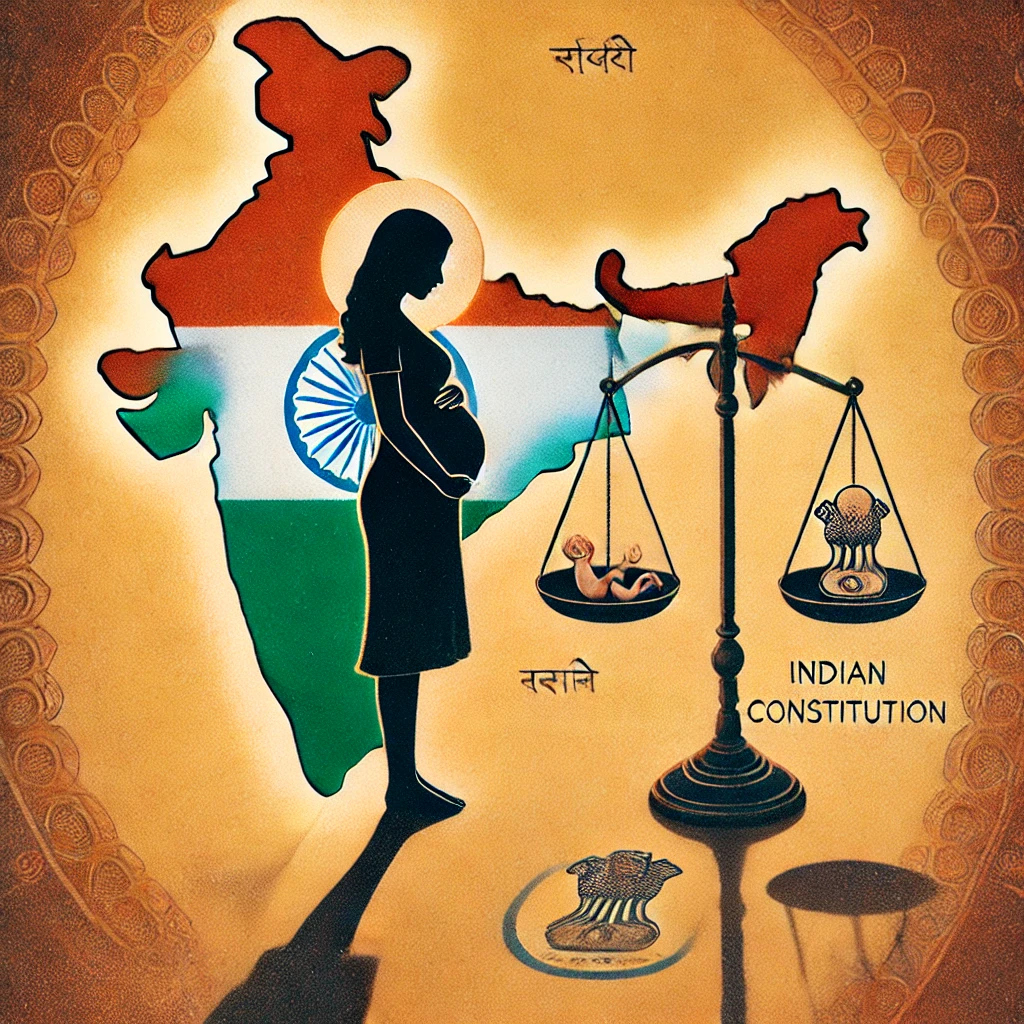
This article has been written by Mulla. Shirina pursuing III Year M.B.B.S. at Govt. Siddhartha Medical College, Vijayawada, Andhra Pradesh, India.

Precis:
Health is a prime factor for the living of human beings. As it is fundamental right of every citizen as enshrined in Constitution of India? We call a Woman in general as an adult female person. The role of a woman is not measurable and she plays a pivotal part in all terms, especially during pregnancy. As Stephen Caskin says “The wisdom and compassion a woman can intuitively experience in childbirth can make her a source of healing and understanding for other women”[1]. This write-up elucidated all about Abortion, its ramifications and how its laws in other Countries.
Abortion:
Abortion is defined as the termination of pregnancy before the foetus becomes viable.
According to Merriam-Webster’s dictionary, Abortion is the induced expulsion of a human fetus[2].
According to R vs. Whitechruch[3], A miscarriage or the premature expulsion of the contents of the womb before the terms of gestation is completed. This has been fixed at 28 weeks when the foetus weighs approximately 1000g.
Abortions are usually categorized as Spontaneous or induced abortions. Miscarriage happens without knowing or without any intervention and it is also called Spontaneous abortion. Spontaneous abortions are considered Nature’s method of birth control. Induced abortions are done by taking deliberate steps to end a pregnancy. Induced abortions may be legal or illegal. During the second or third month of pregnancy, abortion occurs around 10 to 15% of all pregnancies. Abortion is said to be justifiable only when it is done in good faith to save the life of a woman if it is endangering to the mother. When an abortion is performed for medical reasons to save a mother and prevent harm to a woman’s physical or mental health. The procedure is referred to as legal or therapeutic abortion. Criminal abortion is the induced destruction & expulsion of the foetus unlawfully. On average 73 million induced abortions take place globally every year and 61% of all unplanned pregnancies and 29% of all pregnancies end in induced abortion[4]. The rate of abortion is higher in developing countries than in developed countries. In India, an ICMR study documented that the rates of legal and illegal abortions were 6.1 and 13.5 per 1000 pregnancies respectively[5]. Abortions are safe if they are done with a method recommended by the World Health Organization as short WHO. The WHO defines unsafe abortions are those performed by unskilled individuals with hazardous equipment or unsanitary facilities. Data indicates that the seventh & eighth week of gestation is an optimum time for termination of pregnancy.
Legal aspects of Abortions:
The Indian Law majorly focuses on the termination of pregnancy in the Medical Termination of Pregnancy Act, 1971, Act.No.34 of 1971 (hereinafter referred to as the MTP Act, 1971) allowing abortion up to 20 weeks of pregnancy. The Medical Termination Pregnancy (Amendment) Act, 2021, No.8 of 2021 to increase the duration up to 24 weeks. The said amendment expands access and safe abortions in India.
There are five conditions under which pregnancy can be terminated under the MTP Act, of 1971.
- Medical-Where continuation of pregnancy endangers the life of a woman or may cause injury to the physical and mental health of the woman.
- Eugenic: Where there is a risk of a child being born with serious physical or mental abnormalities. For instance, when the pregnant woman in the first trimester suffers from German measles, smallpox, chicken pox, etc., and if the pregnant woman is treated with drugs like Thalidomide, cortisone, aminophine, etc. If a pregnant woman is treated by X-rays or Radioisotopes.
- Humanitarian: when pregnancy is the result of rape
- Social: When pregnancy has resulted from failure of oral contraceptive methods.
- Environmental: When the social or economic environment, expected to injure the pregnant woman’s health.
The Rule 3-B of MTP says that the pregnancy can be terminating exceeding 24 weeks. In the case of X vs. Health and Family Welfare department[6] the concise facts of this case is that, there was an Unmarried women who is an employee got pregnant and on same month her husband abaonded her. She approached to the Delhi High Court, the Court denied to safe abortion as she does not fall under the category of Rule3-B of MTP. The said aggrieved women approached to the Apex Court, the Hon’ble Court consists of three judge bench held that the woman has right to safe abortion and she cannot be denied abortion only because she is unmarried. In the para No.50 from the above judgment as follows “A changed social context demands a readjustment of of our laws. Law must not remain static and its interpretation should keep in mind challenging social context and advance the cause of social justice”. The supra Medical Termination Pregnancy Amendment Act, 2021 to MTP Act, 1971 also specified what is the procedure to abort. If the abortion has to be done in 20 weeks, One Registered Medical Practitioner’s opinion is required for termination, if it is 20-24 weeks Two Registered Medical Practitioners’ opinion is required for termination of pregnancy and after 24 weeks the State Level Board opinion is vital to terminate the pregnancy and the woman who terminates her pregnancy should not be revealed out, it should be kept confidential but it can be revealed according to the procedure of law.
The Punishments for abortion are prescribed under penal laws i.e., Old Law the Indian Penal Code, 1860 from Section 312 to 316 and New Law Bharatiya Nyaya Sanhita, 2023 from Section 88 to 92. At present enforce New Laws from 1st July, 2024.
Section 88 is the same as Section 312 which speaks about “Causing Miscarriage” Whoever voluntarily causes a woman with a child to miscarry, shall, if such miscarriage is not caused in good faith for the purpose of saving the life of the woman, be punished with imprisonment for a term extent to 3 years, if it is woman quick with child may extend upto 7 years, the punishment has changed from old law to new law.
In this section, the word “Good faith” plays a vital part in deciding the case. Section 89 “Causing Miscarriage without Woman’s Consent” Whoever commits the offense under Section 88 without the consent of the woman, whether the woman is quick with child or not shall be punished with imprisonment for life or with imprisonment which may be extended upto ten years and shall also be liable with fine. In this section, there are three aspects to keep in mind. First is that Section 89 shall be read along with Section 88, second is that the word “Without consent” is significant here. The third one is that the punishment prescribed is the culprit has to face a sentence and has to pay a fine “and” added in between sentence and fine.
Subsequently, sections were section 90 “Death caused by act done with intent to cause miscarriage” and section 91 “Act done with intent to prevent child being born alive or to cause after birth. In the case of A (Mother of X) vs. State of Maharashtra and another[7] the consent of pregnant person is prime whether to terminate pregnancy or not and also in X (Minor Victim) vs. Sate of U.P.[8] it is opined by the Allahabad High Court that A women decision or consent is supreme whether to go or not for termination of pregnancy. In ABC vs. State of Gujarat [9] in this case the girl of 15 years of age and with grave injury to the mental health got pregnant due to Unlawful act i.e., Rape. The Gujarat High Court taking into account her age, mental condition and financial status permitted to abort even though she is 28 weeks of pregnant.
Ramifications:
If aborted before 8 weeks there will not be complications or adverse ramifications. The risk will arise if it is done in mid-trimester. The complications would be an injury to the cervix, uterine perforation during dilation and evacuation, hemorrhage and shock due to trauma and incomplete abortion, thrombosis, etc., Post abortal triad of pain, bleeding, and low-grade fever. Vomiting, diarrhea, fever, and uterine pain. Gynecological complications entail menstrual disturbances, chronic pelvic inflammation, infertility, and scar endometriosis. Ectopic pregnancy, etc.,
Other Countries Legal aspects;
As we see the evolution of abortion of pregnancy from the case of Roe vs. Wade, [10] in which one of the Court in United States of America held abortion as illegal and it was followed in 30 states. Later, the same was challenged before Supreme Court of United States of America has legalized the abortion and amended the constitution accordingly and later in the year 2022 Dobbs vs. Jackson Women’s Health Origination[11], the Apex Court of United States of America has overturned the said judgment of Roe vs. Wade.
The abortion laws pertaining United Kingdom is that England, Wales and Scotland are regulated by Abortion Act, 1967 and it is not applicable to Northern Ireland. The said act is legalizing the abortion upto 24 weeks and it has been approved by two independent doctors. The abortion law is one of the oldest health care laws which are existed more than 50 years old. Most of abortion will take place in United Kingdom because they maintain privacy.
Interestingly is that Canada has no law to legalize or to restrict Abortion. Abortion is mentioned in Canada Health Act and it is included in the broad definition of “Insured Health Services”. In the year 1988 R vs. Mergenthaler[12], the Supreme Court of Canada held that any law that restricts woman’s security, life and liberty is said to be Unconstitutional and In Tremblay vs. Daigle[13], opined that fetus has no legal status in Canada as a person either in Quebec Civil Law or Canadian Common Law.
In France, abortion as guaranteed freedom and they have included in their Constitution to guarantee Constructional right[14]. In Colombia the abortion is legal up to 24 weeks and abortion is said to be legal if it is result out of rape and if the women’s health is at risk.
The pan Africa follows the treaty called as Maputo Protocol and it is also knows as African Charter on Human and People’s Rights on the Rights of women in Africa. It is observed as primitive International human rights instrument which guarantee the right to legal abortion. Out of 55 African Countries, 44 Countries have ratified the said protocol. The Article 14(2) (c) of the said Protocol states parties who are signatory/ratified to the protocol to allow abortions if 1. If the pregnant person’s life or health is at right, 2. If the pregnancy is result out of rape, incest and assault and finally 3. In cases of fetal diagnoses[15]. In the year 2019, FIDA Kenya and 3 others vs Attorney General and 2 others- Petition No. 266 of 2015 through this case the abortion matter reached to Court. The Kenya High Court affirms abortion as a constitutional right and upheld to terminate if person’s health or life is at risk.
The pristine Arab and Muslim Country which legalizes the abortion to both married and unmarried is Tunisia. The abortion is also legal to abort even for social reasons and they can abort in public hospitals for free and some recognized private clinics. In the year 2023, this Country has celebrated of 50 years of legalization abortion.
Conclusion:
With each passing day the pregnancy risk increases and health condition differ day by day. By taking risk and carrying baby for months and finally abortion it will make woman to go in shock state. All should heed to the verdict of Sachet Srivastava and another vs. Chandigarh Administration[16] held vide Para No.22 that women’s right to privacy, dignity, and bodily integrity should be respected that entails her right to terminate her pregnancy. The impact of abortion in a society is both positive and negative manner.
[1] https://quotefancy.com/quote/1608286/Stephen-Gaskin-The-wisdom-and-compassion-a-woman-can-intuitively-experience-in-childbirth
[2] https://www.merriam-webster.com/dictionary/abortion
[3] R vs. Whitechruch (1890) 24 QBD 420
[4] https://www.who.int/news-room/fact-sheets/detail/abortion
[5]https://aiims.edu/aiims/events/Gynaewebsite/ma_finalsite/report/1_1_4.htm#:~:text=Estimated%20safe%20and%20unsafe%20abortions,4%20and%206.7%20million%20respectively.
[6] X vs. Health and Family Welfare department 2022 Scowling SC 1321
[7] A(Mother of X) vs. State of Maharashtra and another (2024) SCCOnline SC 835
[8] X(Minor Victim) vs Sate of U.P. (2024) SCC Online All 3921
[9] ABC vs State of Gujarat,(2024) SCC Online Guj 3036
[10] Roe vs Wade, 410 U.S. 113(1973)
[11] Dobbs vs Jackson Women’s Health Organsation, 597 U.S.215(2022)
[12] R vs Morgentaler,[1988] 1 SCR 30
[13] Tremblay vs Daigle-[1982] 2 SCR 530
[14] https://www.bbc.com/news/world-europe-68471568
[15] https://reproductiverights.org/maputo-protocol-at-20/
[16] Suchita Srivastava and another vs Chandigarh Administartion (2009) SCC Online SC 1562






